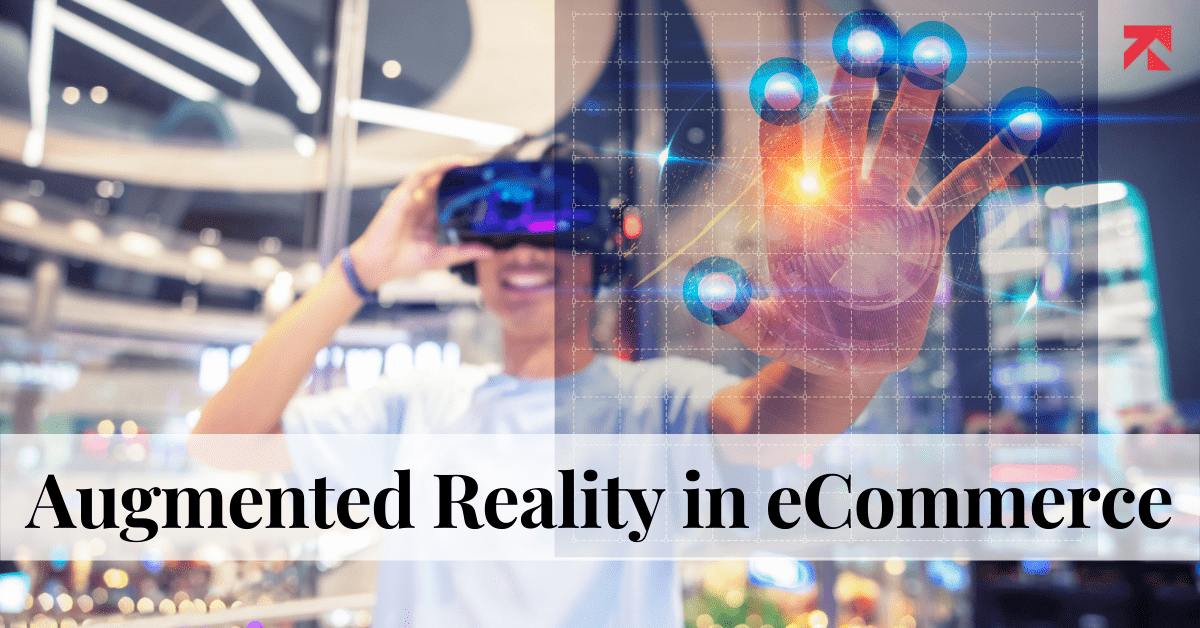admin

Table Of Contents
No doubt, online shopping is all the rage and the eCommerce market shows no sign of slowing down. A surprising fact is that the trend soared immensely during and after the pandemic which resulted in exponential growth of the industry. But, one of the biggest challenges of online shopping is that you miss the charm of going from shop to shop, trying new clothes, feeling the couch material with touch and bargaining to get the best value for your money. While none of it is technically possible, the coming of Augmented Reality in eCommerce has been a breakthrough.
It allowed customers to experience a richer, deeper and more complete shopping without ever leaving the comfort of their home. How? The technology would enter users in a virtual world where they can try on different attires, see products up close and even purchase items in real time.
But there’s more to it than meets the eye! Let’s explore the industrial impact of AR on eCommerce and find out how brands, tech revolutionaries and bustling entrepreneurs are creating new stories and leaving behind footprints for others to follow.
Table Of Contents
The retail market has much to offer when powered by augmented reality applications. Although eCommerce isn’t anything entirely new, there are instances when even the savviest of shoppers need a little extra information. This can be seen as a barrier to selling certain products on a digital platform which prompted companies to introduce augmented reality in shopping with 3D models and a more tailored experience for each buyer.
Often used interchangeably, both augmented and virtual reality are very different in terms of usage, application and build. We’d love to give you a detailed introduction for a better understanding.
Simple augmentation of the real world that we can still perceive to a certain degree is executed by AR. But, for a truly immersive and other worldly experience that lands a user in an artificially created universe, VR is the only best option. Oculus Quest by Meta is the best example of VR technology but, users aren’t meant to experience anything that exists in the real world.
For augmented reality, Pokemon Go can be considered as one of the best applications. It allows users to walk casually down the street, play the game, see the real world through an AR lens, and come across digitally overlaid characters hiding in plain sight. How cool is that!
Tapping into VR would require wearing a headset and holding connected controllers in your hands. Also, users must be careful that the surrounding is safe and wouldn’t trigger any accident as they move. For instance, you definitely don’t want to be someone breaking your houseware with VR wearable. On the contrary, AR requires a simple smartphone and glasses to be in the environment which makes it a preferred option for eCommerce shopping.
Fewer equipment, safety and ease of accessibility makes AR a choice over VR. Whereas the technology would let you tap a broader audience and more or less three billion smartphone users in today’s world.
Different types of AR technologies are built to give users a different experience as each one’s capability also varies. Have a look at some common augmented reality applications!
Also termed as Image Recognition or Recognition-based AR, these applications are capable of detecting an object in front of the camera lens (known as “the marker”). And when the focus is set, users can see the information of the marker to find out more about it and even purchase in real-time, should the feature be included! Each time when AR detects the marker, application using the technology swaps it with a 3D version of the corresponding object, giving a closed view from many different angles.
You don’t need real world objects to trigger marker-less AR but, all you need to do is placing a virtual object anywhere, drag, rotate, pick-up and move it in any direction.
Works like a marker-less AR using geographical locations as hotspots to display digital content when focused on a particular area or certain locations. Again, Pokémon Go is the finest example of location-based AR.
Casting synthetic light onto physical objects and surfaces to interact with the focus subject can be done through projection-based AR. Holograms used in sci-fi movies like Star Wars are the best examples whereas the technology isn’t anymore fictional.
Just in-case you’re one of those AR development companies and leading services providers, the stats are in your favor. AR tech is making some huge leaps in the world of marketing, eCommerce and entertainment. The numbers below would make you believe:
The convenience of experiencing services and products right from the comfort of your home at any time of the day is one of the biggest benefits of AR. With AR, retailers let their customers preview products in real-time and pick the right thing in the first go.
“Perhaps, this would complement best with green.” – Almost everyone would say this after trying on a new attire and realize it doesn’t suit them somehow. With online shopping, such could reduce the conversion rates and shoppers do want to know what they’re paying for while taking all precautionary steps.
This is where AR in eCommerce comes into play as the technology allows shoppers to understand and even see themselves trying the items or products before making a purchase. In-fact, there are various Augmented Reality applications like this for makeup, clothing, eyeglasses, accessories and likewise products.
Ever wonder how that couch would look in your room? Or, how would a big screen television fit on your living room’s wall? To comprehend such things can be difficult, even when you’re visiting a physical store but not with AR shopping. And you definitely don’t need to look it up on a computer or small mobile screen.
Previewing placements is another neat feature you get with AR in eCommerce, giving customers a real-time glimpse of a product when placed or installed in the actual environment. A lot of furniture and electronic stores are offering the technology and benefiting a lot of customers.
Interactive user manuals with AR are the best bet when selling products that require a clear understanding, or when users need to learn about the technical aspects in order to gauge their value. Where technical specifications and jargons fail, Augmented Reality in eCommerce would let a user experience a certain product in a controlled environment which clearly communicates about the value and usage. There are many AR applications with user manuals that can scan a particular product, indicate buttons and controllers in a real environment through graphical representations and creative animation.
AR filters and lenses are quite popular among famous applications like Snapchat and Instagram Stories. Where once used purely for fun and entertainment, there has been a tremendous shift in the trend as brands all over the world hop on the AR bandwagon and put technology to their advantage through social media filters. A few benefits worth outlining are:
The difficulty and near inability to represent a physical, 3D product in a virtual 2D environment is a huge setback in the world of eCommerce. But when using AR in eCommerce, you make it easier for consumers to understand the merchandise, see it in the actual setting and purchase using in-app buying features. You must’ve a dozen creative eCommerce ideas on your mind and fusing those with Augmented Reality can help you:
AR is interactive and persuading enough for users to land and stay on your online store for longer. And the longer they would stay, greater are the chances of conversions. Improved engagements build brand loyalty that is likely to be remembered and admired in the long run, even if customers do not convert on the first visit.
Creating a buzz, a hype and an engaging campaign for your eCommerce store using Augmented Reality is the best way to reach a new audience and retain your existing customer-base. Brands and retailers can offer a lot more product information to users as opposed to a static image or video. 3D representations in real environments further provokes confidence among users to make an informed decision when purchasing which reduces cart abandonment rate and backlashes.
If you’re already inspired and ready to bring AR in eCommerce for your business, here’s what you can do to make the transition smooth and flexible.
What do you want to achieve in the eCommerce sector with Augmented Reality? What are the benefits and offerings to your customers? Be sure you’ve a clear answer for both queries to make an AR application work wonders for your business. Before hopping onto the technical bandwagon, figure out your vision and mission. Move in the right direction and be as flexible as possible to make the journey smooth.
Once you’re clear on what you wish to create and achieve, it’s time to pick the AR tools that can help you elevate your store. A few considerable factors are:
Finally, you’ve invested all your time, effort and money in creating a perfect Augmented Reality tool for an exceptional eCommerce experience. But it won’t do you any good unless the world out there knows about it. Here’s how to market:
Ecommerce stores are using Augmented Reality to reshape in-store experiences and alleviate customer concerns. All the new trends in technology expect customers to immerse themselves in a world of possibilities and rich, digital experiences.
Table Of Contents

